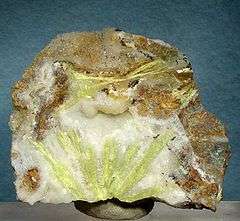Carpathite
| Carpathite | |
|---|---|
|
Carpathite from New Idria District, California USA | |
| General | |
| Category | Organic mineral |
| Formula (repeating unit) | C24H12 |
| Strunz classification | 10.BA.30 |
| Crystal symmetry |
Monoclinic prismatic H-M symbol: (2/m) Space group: P 21/a |
| Unit cell | a = 10.03 Å, b = 4.69 Å, c = 16.01 Å; β = 111°; Z = 2 |
| Identification | |
| Color | Yellow, yellowish brown on exposure |
| Crystal habit | Acicular to thin tabular in bladed groups and fibrous radiating aggregates |
| Crystal system | Monoclinic |
| Cleavage | Perfect on [001], [100] and [201] |
| Fracture | Splintery |
| Tenacity | Flexible, nearly plastic |
| Mohs scale hardness | 1.5 |
| Luster | Vitreous - adamantine |
| Streak | Yellow white |
| Diaphaneity | Transparent |
| Specific gravity | 1.35 |
| Optical properties | Biaxial (+/-) |
| Refractive index | nα = 1.760 - 1.780 nβ = 1.780 - 1.982 nγ = 2.050 - 2.150 |
| Birefringence | δ = 0.290 - 0.370 |
| Other characteristics | Fluorescent - electric blue to blue-green |
| References | [1][2][3] |
Carpathite (also pendletonite and karpatite) is a very rare hydrocarbon mineral. It is the mineral form of the polycyclic aromatic hydrocarbon coronene with formula: C24H12.
It was first described in 1955 for an occurrence in Transcarpathian Oblast, Ukraine. It was named for the Carpathian Mountains. It has also been reported from the Presov Region of the Slovak Republic, the Kamchatka Oblast in Russia and from San Benito County, California.[1]
It occurs at the contact zone of a diorite intrusive into argillite within cavities in the Ukraine. In the California occurrence it appears as a low temperature hydrothermal phase. It is associated with idrialite, amorphous organic material, calcite, barite, quartz, cinnabar and metacinnabar.[3]
References
| Wikimedia Commons has media related to Carpathite. |
This article is issued from Wikipedia - version of the Tuesday, July 14, 2015. The text is available under the Creative Commons Attribution/Share Alike but additional terms may apply for the media files.
